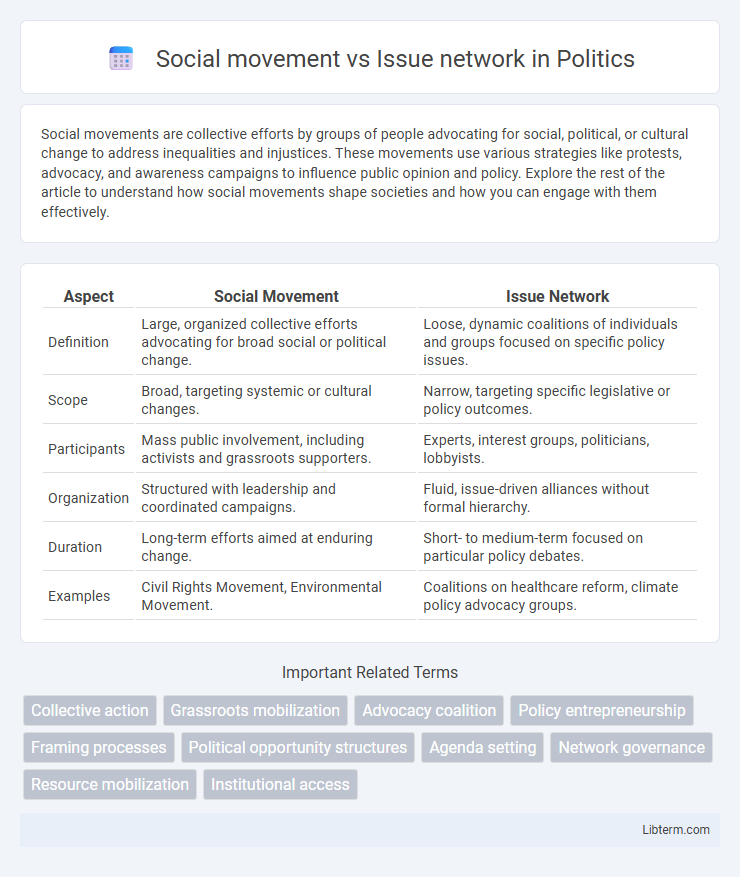Social movements are collective efforts by groups of people advocating for social, political, or cultural change to address inequalities and injustices. These movements use various strategies like protests, advocacy, and awareness campaigns to influence public opinion and policy. Explore the rest of the article to understand how social movements shape societies and how you can engage with them effectively.
Table of Comparison
| Aspect | Social Movement | Issue Network |
|---|---|---|
| Definition | Large, organized collective efforts advocating for broad social or political change. | Loose, dynamic coalitions of individuals and groups focused on specific policy issues. |
| Scope | Broad, targeting systemic or cultural changes. | Narrow, targeting specific legislative or policy outcomes. |
| Participants | Mass public involvement, including activists and grassroots supporters. | Experts, interest groups, politicians, lobbyists. |
| Organization | Structured with leadership and coordinated campaigns. | Fluid, issue-driven alliances without formal hierarchy. |
| Duration | Long-term efforts aimed at enduring change. | Short- to medium-term focused on particular policy debates. |
| Examples | Civil Rights Movement, Environmental Movement. | Coalitions on healthcare reform, climate policy advocacy groups. |
Defining Social Movements
Social movements are organized collective efforts by large groups aiming to promote or resist change in societal norms, values, or policies, often driven by a shared ideology and sustained activism. They differ from issue networks, which are looser, more specialized coalitions of interest groups, government officials, and experts focused on specific policy issues with flexible, short-term alliances. Defining social movements involves recognizing their grassroots nature, widespread participation, and long-term commitment to transformative social change.
Understanding Issue Networks
Issue networks consist of diverse stakeholders, including policymakers, experts, interest groups, and media, who collaborate on specific policy problems through fluid and evolving relationships. These networks are characterized by their openness, technical expertise, and ability to influence legislative agendas by providing specialized information and framing policy debates. Understanding issue networks reveals how decentralized and dynamic policy-making processes rely on ongoing interactions among multiple actors rather than centralized control.
Core Differences Between Social Movements and Issue Networks
Social movements are broad, loosely organized collective efforts aimed at promoting or resisting societal change, often involving diverse groups united by shared values and long-term goals. Issue networks consist of more specialized, loosely connected individuals and organizations focused on specific policy issues, operating primarily within political or bureaucratic arenas. The core difference lies in social movements' emphasis on widespread cultural or social transformation, while issue networks concentrate on influencing policy outcomes within narrower, technical domains.
Historical Evolution of Social Movements
Social movements have evolved from early labor and civil rights campaigns in the 19th and 20th centuries into complex, organized efforts advocating for broad social change, contrasting with issue networks that consist of specialized interest groups focused on specific policy areas. The historical evolution of social movements illustrates a shift from localized, grassroots activism toward globalized, digitally connected campaigns influencing public opinion and legislation. This development highlights the increasing role of mass communication, identity politics, and coalition-building in shaping social movements' strategies and impacts.
The Rise of Contemporary Issue Networks
The rise of contemporary issue networks reflects a shift from traditional social movements towards more flexible, decentralized coalitions of actors united by specific policy concerns. Issue networks encompass a diverse range of stakeholders including government officials, interest groups, experts, and media who collaborate to influence public policy on narrowly defined issues. This new form of political mobilization leverages digital communication technologies to coordinate efforts and shape discourse across complex governance landscapes.
Structure and Organization: Movements vs. Networks
Social movements typically feature a grassroots structure with broad membership and decentralized leadership, fostering collective identity and mass mobilization. Issue networks consist of more specialized, loosely connected actors including interest groups, experts, and policymakers collaborating on specific policy concerns. This networked organization allows for flexible, targeted advocacy without the hierarchical framework characteristic of social movements.
Influence on Policy and Decision-Making
Social movements mobilize large groups to create widespread public pressure, significantly shaping policy agendas and influencing legislative priorities through collective action and advocacy. Issue networks consist of interconnected stakeholders, such as interest groups, policymakers, and experts, working collaboratively to directly provide information and shape detailed policy decisions. The influence of social movements is often broad and grassroots-driven, while issue networks exert targeted, specialized impact within specific policy realms.
Mobilization Strategies and Tactics
Social movements employ grassroots mobilization strategies such as protests, rallies, and community organizing to generate broad public engagement and direct action. Issue networks rely more on institutional tactics, including lobbying, coalition-building among interest groups, and expert testimony to influence policy within formal political channels. Both mobilization approaches aim to effect change but differ in scale, with social movements focusing on mass participation and issue networks leveraging specialized knowledge and strategic alliances.
Case Studies: Notable Examples
The Civil Rights Movement exemplifies a powerful social movement that mobilized large-scale public engagement to challenge systemic racial discrimination, achieving landmark legislation like the Civil Rights Act of 1964. In contrast, the Environmental Protection Agency's (EPA) Clean Air Act showcases an issue network where policymakers, scientists, industry representatives, and advocacy groups collaborate continuously to shape specific environmental regulations. These cases demonstrate how social movements drive broad societal change through mass mobilization, whereas issue networks focus on specialized policy development through expert negotiation.
Future Trends in Advocacy and Collective Action
Social movements are broad, grassroots efforts that mobilize large groups around deep-seated social or political change, while issue networks consist of specialized stakeholders focused on specific policy areas. Future trends in advocacy emphasize digital mobilization, data-driven strategies, and decentralized leadership to enhance collective action's reach and impact. Advances in AI and social media analytics will enable more targeted and adaptive campaigning, reshaping how social movements and issue networks influence public policy.
Social movement Infographic

 libterm.com
libterm.com